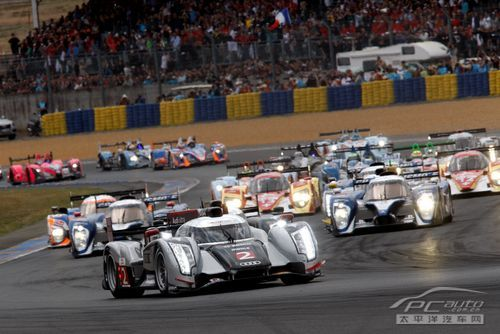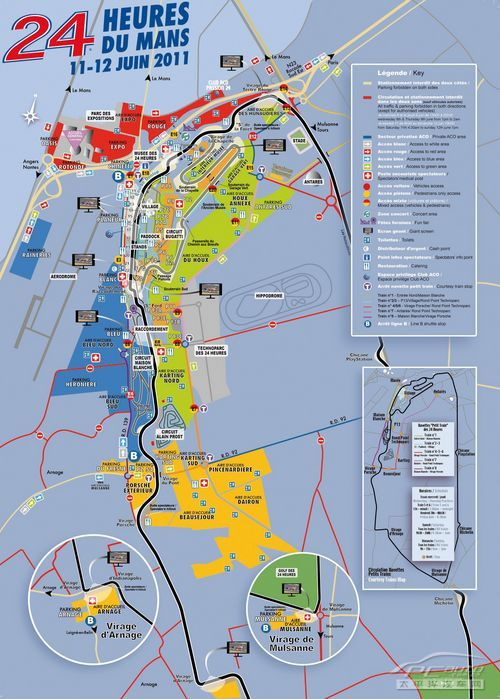The 24 Hours of Le Mans: A Grueling Test of Speed and Endurance
 JamesFeb 23, 2024, 09:25 PM
JamesFeb 23, 2024, 09:25 PM
Explanation of the 24 Hours of Le Mans
The 24 Hours of Le Mans (French: 24 Heures du Mans) is a major event held in the small town of Le Mans, 200 km southwest of Paris, second only to F1 in global influence. Unlike the F1 Grand Prix, which imposes technical restrictions such as turbocharging, the Le Mans endurance race allows for an average car speed of about 370 km/h over 2/3 of the course, and cars can reach up to 404 km/h on the straights. It is the ideal platform for car manufacturers to demonstrate their vehicles' performance and reliability.
It is held at the Le Mans circuit in France on the second weekend of June each year. The event is organized by the Western Automobile Club of France (Automobile Club de l'Ouest, ACO).
In recent years, the race has been divided into four categories: LMP1 (such as Audi R10, Peugeot 908 HDi, closest to the historical Group C prototype positioning), LMP2 (e.g., Courage LC75), GT1 (like Chevrolet Corvette C6R and Aston Martin DBR9), and the entry-level GT2 (e.g., Ferrari F430 GT).
The 24 Hours of Le Mans itself has also given rise to several championships, namely the Le Mans Endurance Series and the American Le Mans Series. In 2006, Japan also introduced a new All-Japan Le Mans Series.

Introduction to the track of the 24 Hours of Le Mans
The endurance championship's race lengths are mainly 1000km, 1610km, 5000km, and 8050km, with time durations of 6h, 12h, and 24h; among them. The 1000km auto race and the 24 Hours of Le Mans are the most famous. From 1984, FISA stipulated that a Group C car would not be less than 850kg in weight and that the fuel consumption for a 100km race would not exceed 60L. In 1992, FISA further stipulated that all Group C cars would adopt naturally aspirated engines, with the usual race length being 480km. The endurance auto race is a severe test of both the car's performance and the endurance of the driver; it's a tough competition.
The Le Mans race is the most famous in the world, surpassing the Indy 500 or any other auto race, because the typical endurance race is only 500-1000km, while Le Mans is about 5000km. Some people say that it's a scale-organized gambling event, sacrificing many people's lives to boost the fame of a few auto manufacturers. Regardless of how dangerous the Le Mans track is, or how many tragedies have occurred in history, the Le Mans race is held as scheduled in June each year. Some automakers spare no expense, spending millions of dollars to win this race and seize the opportunity to boost their company's reputation.
The types of cars participating in the World Endurance Championship (World Endurance Championship) are mainly Group C Sports Prototype cars. These cars can seat two people who take turns driving. In addition, The cars can be divided into two levels: LMP and GT group. LMP is further divided into LMP1 and LMP2 according to speed, weight, and other factors. Similarly, the GT group is divided into GT1 and GT2 groups.

The perilous 24 Hours of Le Mans
1955 Le Mans Disaster
On 11 June 1955, the Le Mans disaster occurred. French driver Pierre Levegh, driving a Mercedes-Benz 300SLR racing car, crashed into Lance Macklin's Austin-Healey 100 and rushed into the spectator stand, causing a serious accident that killed Levegh himself and 83 spectators, and injured 120 people. It’s the deadliest accident in racing history, judged by the number of fatalities. Finally, the race was won by Mike Hawthorn's Jaguar D-Type. The French media scorned Mike Hawthorn and his teammate Bueb for spraying champagne on the awards podium.
After the accident, Mercedes-Benz and Jaguar announced their withdrawal from motorsport, and France, Spain, Switzerland, and Germany also announced a ban on motorsport events in their countries. Mercedes-Benz and Jaguar returned to motorsport in the 1980s, while Switzerland still did not allow motorsport events to this day.

If any infringement occurs, please contact us for deletion
Trending News

BYD Sealion 7 is not only cheaper than Tesla Model Y, what other differences do they have?
Is it better to buy the BYD Sealion 7 or the Tesla Model Y? This really makes one a bit hesitant, but before you make a decision, I recommend you take a good look at this article.

2026 Toyota Hilux Travo released, the brand-new exterior and interior are highly anticipated
If you're considering buying a Hilux, honestly, the comprehensive innovations in the ninth generation are worth waiting for. While the current model might still have some advantages in terms of reliability and price, the new model offers significant changes in terms of exterior and interior luxury, tech features, and powertrain options.

Toyota Land Cruiser FJ did not disappoint, the most anticipated civilian off-road vehicle is back.
Since its birth in 1951 under the name Toyota BJ, the Land Cruiser series has accumulated sales of approximately 12.15 million units in over 190 countries and regions worldwide, becoming a global off-road icon spanning more than 70 years.

In Malaysia, which sliding door MPVs are available?
The numerous advantages of sliding door MPVs make many people fond of this type of vehicle. However, MPVs are not a mainstream choice in the car market, so many people might not know which MPVs are available domestically.

Should I choose the top-tier Toyota Corolla Cross, or the entry-level Fortuner?
Should we spend more money on a compact SUV, or add a bit more to buy a larger SUV? Although for many families, the 20,000 MYR price difference is not a small amount, considering that the number of family members may increase in the future, choosing a more practical and spacious car can save the trouble and cost of replacing a vehicle later on.
Popular Cars
Model Year
Car Compare
Car Photo

